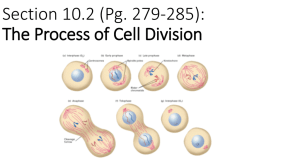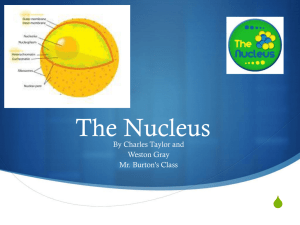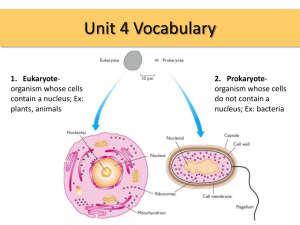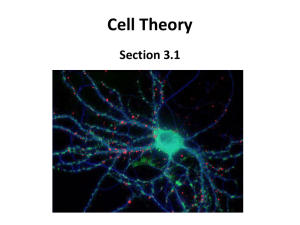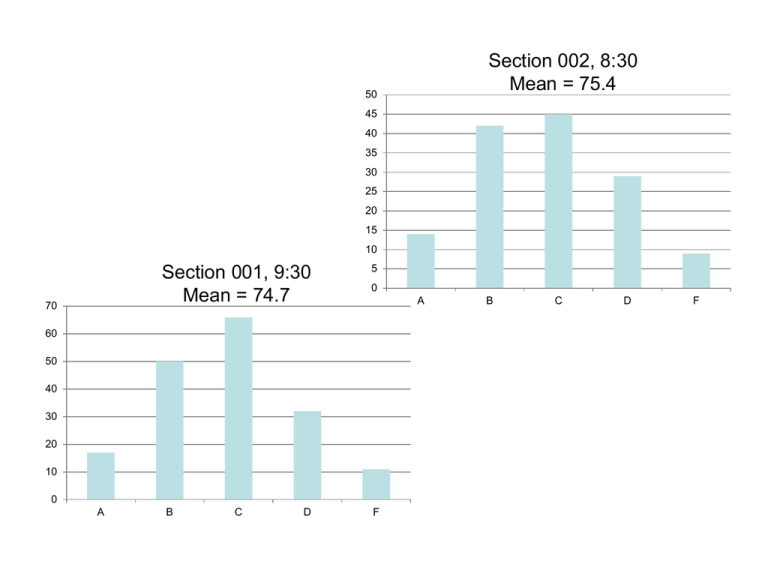
Section 002, 8:30
Mean = 75.4
50
45
40
35
30
25
20
15
10
Section 001, 9:30
Mean = 74.7
70
5
0
A
60
50
40
30
20
10
0
A
B
C
D
F
B
C
D
F
Chapter 12:
The Cell Nucleus and Control
of Gene Expression
The Cell Nucleus…
• Every somatic cell contains the same genetic information
regardless of whether it is expressed the same way.
• Just as in a building under construction, all workers have
access to the complete set of blueprints.
• However, the workers constructing the floors only use
the information related to their work and the workers
installing the wiring only use the information related to
their project.
• Brain cells only express genes related to brain activity
and liver cells only express the genes related to their
activity.
The Cell Nucleus…
• The nucleus of most
cells is typically
amorphous and
consists of:
– The chromosomes (in
the form of chromatin)
– Nucleoli
– Nucleoplasm
– The nuclear matrix
• All surrounded by the
nuclear envelope
The Cell Nucleus…
• The nuclear envelope is complex; consists
of several distinct components: 2 cellular
membranes arranged parallel to one
another & separated by 10 - 50 nm
– Separates genetic material in nucleus from
cytoplasm - important distinction between
prokaryotes & eukaryotes; an evolutionary
landmark
• 1. Serves as barrier; keeps ions, solutes,
macromolecules from passing between nucleus &
cytoplasm
The Cell Nucleus…
• The nuclear envelope…
– B. Fused at sites forming circular pores that
contain complex assemblies of proteins
• 1. Average mammalian cell: contains ~3000
nuclear pores
• 2. Pore density: ~2-4/μm2 (metabolically inactive
bird erythrocyte) to >60/μm2 (active oocyte)
– C. Outer membrane is generally studded with
ribosomes
The Cell Nucleus…
• The nuclear
envelope…
– D. Inner surface of the nuclear
envelope of animal cells is
bound by integral membrane
proteins to a thin filamentous
meshwork (nuclear lamina)
• 1. Provides mechanical support
to nuclear envelope & serves
as a site of attachment for
chromatin fibers
• 2. Different mutations in 1 lamin
gene (LMNA) are responsible
for several human diseases,
e.g., a rare form of muscular
dystrophy and progeria
The Cell Nucleus…
• The nuclear pore
complexes…
– the gateways across the
barrier of the nuclear
envelope
• Many molecules, including
RNAs & proteins, are
transported in both directions
across the nuclear envelope
– One HeLa cell nucleus must
import ~560,000 ribosomal
proteins & export ~14,000
ribosomal subunits per minute
The Cell Nucleus…
• The nuclear pore
complexes…
– a complex, basketlike apparatus,
the NPC; projecting into both the
cytoplasm & nucleoplasm
• Depending on species, NPCs
contain ~30 different proteins
The Cell Nucleus…
• The nuclear pore complexes…
– Proteins to be imported to the nucleus have a
stretch of amino acids that acts as a nuclear
localization signal (NLS)
• The sequence enables a protein to pass through
nuclear pores & enter nucleus
• Best studied or classical NLS have 1 or 2 short
stretches of positively charged amino acids
• Modifying the signal can prevent entry of
polypeptides or allow entry of proteins not typically
located in the nucleus
The Cell Nucleus…
• The nuclear pore complexes…
– Transport receptors are proteins that move
molecules in and out of the nucleus
• Importins move macromolecules into the nucleus
• Exportins move them out
The Cell Nucleus…
•
Nuclear import
1.
2.
3.
NLS protein binds to
importin dimer
Trimer binds to
cytoplasmic filament
Whole complex is
imported through the pore
4. Ran-GTP causes
dissociation of NLS from
importin complex
5. Ran-GDP and the importin
proteins are exported to
the cytoplasm
6. Ran-GDP is reimported to
the nucleus and converted
back to Ran-GTP
The Cell Nucleus…
• Chromosomes and chromatin…
– The average human cell has ~6 billion bp divided
among 46 chromosomes (0.34 nm/bp x 6 billion bp; 2
meters long)
• A. An unreplicated chromosome is a single, continuous DNA
strand
– 1. How does it fit into a cell nucleus (10 μm in diameter) & still
perform its functions by remaining accessible to enzymes and
regulatory proteins?
– 2. How is the single DNA molecule of each chromosome
organized so that it does not become hopelessly tangled with
the molecules of the other chromosomes?
– 3. The answer to both of the above questions is packaging
The Cell Nucleus…
• Chromosomes and chromatin…
– Chromosomes are made of DNA & associated
proteins, chromatin - highly extended nucleoprotein
fibers
– Two major groups of proteins - histones & nonhistone
• 1. Histones - small, well-defined basic protein group; very
high lysine and/or arginine content
• 2. Nonhistone proteins - many widely diverse structural,
enzymatic & regulatory proteins
– Understanding how histones and DNA interact is the
first step in understanding how DNA is packaged.
The Cell Nucleus…
• Chromosomes and chromatin…
– The orderly packaging of eukaryotic DNA depends on histones,
– Nucleosomes: repeating subunits of DNA and histones
– Histones are divided into 5 distinct classes distinguished by
arginine/lysine ratio & posttranslational modifications
(phosphorylation & acetylation)
The Cell Nucleus…
• Chromosomes and chromatin…
– Histone amino acid sequences particularly H3 &
H4 are very conserved & have changed very little
over long periods of evolutionary time - H4 of
peas & cows vary in only 2 amino acids out of 102
– Why?
– 1. Histones interact with the DNA backbone,
which is identical in all organisms
– 2. Nearly all amino acids in a histone molecule
interact with either DNA or another histone; thus,
very few amino acids in a histone can be replaced
with another without severely affecting its function
Review from last time
• Every cell in an organism contains all of the
information in every other cell but only uses
some of that information
• The nucleus is made up of a 2-layer membrane,
a lamina, chromatin, nuclear pore complexes,
etc.
• Some proteins are moved into and out of the
nucleus via importins, exportins and nuclear
localization signals
• Histones are very well-conserved proteins critical
to chromatin structure and DNA packaging
The Cell Nucleus…
• Chromosomes and
chromatin…
– Nucleosomes
• 1. Each nucleosome contains a
nucleosome core particle - 146 bp
of supercoiled DNA
• 2. DNA wraps almost 2X around
disc-shaped, 8 histone complex,
the histone core
• 3. The histone core - 2 molecules
each of H2A, H2B, H3 & H4;
human cell contains ~300 million
histones
• 4. H1 called the linker histone
The Cell Nucleus…
• Chromosomes and chromatin…
– Nucleosomes
• 5. Together H1 protein & the histone octamer
interact with ~168 bp of DNA
– This first level of packaging
condenses DNA by a 7:1 ratio
The Cell Nucleus…
• Chromosomes and
chromatin…
– Higher level structure
• 30 nm fibers
• The assembly of the 30 nm fiber
increases packing ratio another 6-fold
(~40-fold all together)
• Maintenance depends on the
interaction between histones of
neighboring nucleosomes
• Probably via their long, flexible tails
The Cell Nucleus…
• Chromosomes and chromatin…
• H4 histone N-terminal tail from 1 nucleosome core particle
can reach out & make extensive contact with both linker DNA
between nucleosome particles & H2A/H2B dimer of adjacent
particles
• Chromatin fibers prepared with histones lacking their tails
cannot fold into higher-order fibers
The Cell Nucleus…
• Chromosomes and chromatin…
– Next level of packaging –
– supercoiled loops of 30-nm chromatin
fiber compacted into even thicker (80
– 100 nm) fibers
• DNA loops begin & end with AT-rich
sequences tethered to proteins of an
organized nuclear scaffold or matrix
• normally spread out within nucleus &
cannot be visualized, their presence
can be revealed under certain
circumstances
The Cell Nucleus…
• Chromosomes and
chromatin…
– The mitotic chromosome
is the organization level
during cellular reproduction
– 1 μm of chromosome
length has ~1 cm of DNA;
the ultimate in
chromosome compactness
with a packing ratio of
10,000:1; the compaction
occurs by poorly
understood processes
– movie
The Cell Nucleus…
• Heterochromatin and Euchromatin…
– During normal cell function chromatin is less
organized
• A. Heterochromatin – chromatin that remains
compacted during interphase; found at nuclear
periphery (~10% in humans)
• B. Euchromatin – chromatin that returns to
dispersed state after each mitosis
The Cell Nucleus…
• Heterochromatin and Euchromatin
– Heterochromatin- divided into 2 classes
depending on whether it's permanently or
transiently compacted
• A. Constitutive heterochromatin - stays condensed
in all cells at all times; permanently silenced DNA
– Consists primarily of repeated DNA sequences &
contains relatively few genes
The Cell Nucleus…
• Heterochromatin and Euchromatin
– Heterochromatin…
• B. Facultative heterochromatin - specifically
inactivated during certain phases of organism's life
or in certain types of differentiated cells;
• one example: X chromosome in female mammals
– 1. Male cells have a tiny Y chromosome & much larger X
chromosome; since X & Y chromosomes have only a few
genes in common, males have a single copy of most
genes carried on sex chromosomes
– 2. In female mammals, only one X chromosome is
transcriptionally active; why?
The Cell Nucleus…
• Heterochromatin and Euchromatin
– Heterochromatin…
• Facultative heterochromatin – 3. The other X chromosome is condensed as
heterochromatic clump (Barr body) early in embryonic
development
The Cell Nucleus…
• Heterochromatin and Euchromatin
– X chromosome inactivation – The Lyon hypothesis:
• A. Heterochromatization of X chromosome in female
mammals occurs during early embryonic development &
leads to inactivation of genes on that chromosome
• B. Heterochromatization in embryo is random process in the
sense that the paternally-derived & maternally-derived X
chromosomes have equal chances of being inactivated in
any given cell
• Once X chromosome is inactivated, same X chromosome is
inactivated in all of the cell's descendants
• C. Heterochromatized X chromosome is reactivated in germ
cells before meiosis (the creation of gametes); all gametes
get a euchromatic X chromosome
The Cell Nucleus…
• Heterochromatin and Euchromatin
– The consequences of X-inactivation
• Adult mammalian females are genetic mosaics
(with different alleles functioning in different cells)
– A. This is true since paternal & maternal X chromosomes
may have different alleles for same trait
– B. X-linked pigment genes in cats – calico
– C. Pigmentation genes in humans are not found on X
chromosome so there are no calico women, but…..
The Cell Nucleus…
• The Histone Code
– Cells contain a wide array of enzymes that
can add or remove chemical groups to or from
amino acid residues in the histone tails
– The histone code hypothesis
– 1. The state & activity of a particular region of chromatin
depends upon the specific modifications, or combination
of modifications, to the histone tails in that region
– 2. The pattern of modifications on the tails of the core
histones contains encoded information governing the
properties of the nucleosomes containing them
The Cell Nucleus…
• The Histone Code
– Two interrelated chromatin properties were shown to
depend upon histone modification patterns
– 1. The degree of compaction –whether a region of
chromatin is heterochromatic or euchromatic
– 2. The likelihood that a gene or cluster of genes will be
transcribed
Acetylation decreases the positive charge in the N-terminal
tails of histones H3 and H4.
A positive charge is replaced by a neutral acetyl group.
This reduces the interaction strength of the nucleosome
with the negatively charged phosphate backbone of DNA.
A more open chromatin that can be more easily unwound
and is more accessible to the transcriptional machinery.
Review from last time
• The ultimate in DNA packaging compacts the
genome by a factor of 10,000:1 and into a mitotic
chromosome.
• Euchromatin spends much of its time dispersed
in the genome and is actively transcribed
• Heterochromatin spends most of its time
compacted and can be either constitutively
compacted or facultatively compacted
• X-inactivation is an example of facultative
heterochromatin
• Karyotypes are organized depictions of the
chromosomes in a genome
The Cell Nucleus…
• Mitotic Chromosomes…
– Interphase chromosome DNA is very dispersed so it can be
accessed for replication and transcription
– Mitotic chromosome DNA is in its most highly condensed state &
favors delivery of an intact DNA package to each daughter cell
– Have characteristic shapes determined by DNA length &
centromere position
– karyotype – matched homologous pairs placed in order of
decreasing size
The Cell Nucleus…
• Chromosomal aberrations…
– Inversions – portions of chromosomes that
have been reversed in orientation
• Most of the pericentric (around the centromere) inversions
observed in humans do not in themselves give rise to any
specific phenotypic abnormalities.
• However pericentric inversion has been found to be
associated with infertility (problems in meiosis)
The Cell Nucleus…
• Chromosomal abnormalities
• Inversions
The Cell Nucleus…
• Chromosomal abnormalities
• Inversions
B
A
A
B
C
C
D
D
E
E
The Cell Nucleus…
• Chromosomal aberrations…
– Translocations – portions of chromosomes that are
transferred to different chromosomes
– Emanuel syndrome – an unbalanced 11;22
translocation
• cleft palate, heart defects, ear anomalies, genital anomalies
in males, muscular hypotonia (low muscle tone) and
moderate to severe mental deficiency.
The Cell Nucleus…
• Chromosomal aberrations…
– Deletions – just what it suggests
• ~ 50 to 60 children are born with 5p- Syndrome
(five p minus) in the U.S. each year
• aka Cri du Chat Syndrome.
• 5p- Syndrome is characterized at birth by a high
pitched cry, low birth weight, poor muscle tone,
microcephaly, and potential medical complications.
The Cell Nucleus…
• Chromosomal aberrations…
– Duplications – repeated portions of
chromosomes
• Individuals may be affected differently depending
on the duplicated region and the extent of the
duplication
– Trisomy, monosomy
The Cell Nucleus…
• Telomeres - stretches of repeated
sequences at DNA molecule tips
forming a cap at each end of the
chromosome
– The sequence below repeated ~500 5,000 times in humans; same one seen in
all vertebrates & it is similar in most other
organisms
TTAGGG
AATCCC
• High degree of similarity suggests
among diverse organisms suggests…
The Cell Nucleus…
• Telomeres and the end-replication problem…
– DNA polymerases do not initiate DNA synthesis; they can
only add DNA to the 3' end of an existing strand (a primer);
they need a primer to start replication at the 5' end of new
DNA strand
– 1. Replication is started by synthesis of an RNA primer at 5'
end of the new strand;
– 2. The primer is then removed
• The new strand's 5' end is missing a short piece (~8-12
nucleotides).
The Cell Nucleus…
• Telomeres and the end-replication
problem…
• 3. Rather than existing as an unprotected, singlestranded terminus, the overhanging strand is tucked
back into the double-stranded portion of the telomere to
form a loop
• 4. This conformation may protect the telomeric end of
DNA from proteins that normally recognize singlestranded DNA & trigger a DNA repair response
• If cells were not able to replicate the ends of their
DNA, the chromosomes would be expected to
become shorter & shorter with each round of cell
division
The Cell Nucleus…
• Telomeres and telomerase…
– Telomerase is an enzyme that can add new repeat
units to chromosome ends
– A ribonucleoprotein
– Telomerase is a reverse transcriptase that
synthesizes DNA using an RNA template, but unlike
most reverse transcriptases, the RNA serving as the
template is an integral part of enzyme
– Animation
http://faculty.plattsburgh.edu/donald.slish/Telomerase.html
The Cell Nucleus…
• Telomeres and telomerase…
– Telomere functions
• A. Required for complete
replication of the chromosome
• B. Form caps that protect
chromosomes from nucleases &
other destabilizing influences
• C. Also prevents chromosome
ends from fusing with one another
The Cell Nucleus…
• Telomeres and telomerase…functions
– A. Dermis fibroblast experiment
• 1. Plate fibroblasts on nutrient media
• 2. Remove a fraction & replate, they would once again proliferate,
• 3. After ~50 – 80 population doublings, the cells stop dividing &
eventually die
• 4. One finds a dramatic decrease in telomere length over time in
culture
• 5. Most cells lack telomerase & are unable to prevent the loss of
their chromosome ends
• 6. Shortening is thought to continue to a critical point (a crisis),
when cells exhibit extensive chromosome abnormalities & stop
dividing
• 7. A similar decrease in telomere length is found in somatic cells
from an elderly adult as compared with telomeres in corresponding
cells from an infant or young child
The Cell Nucleus…
• Telomeres and telomerase…functions
– B. Unlike somatic cells, germ cells of gonads retain
telomerase activity
– C. Telomere shortening plays a key role in protecting humans
from cancer
• A. Malignant cells are cells that have escaped the body's
normal growth control & keep dividing indefinitely
– 1. Unlike normal cells that lack detectable telomerase
activity, ~90% of human tumors consist of cells that contain
an active telomerase enzyme
– 2. The other 10% or so have an alternate mechanism
based on genetic recombination that maintains telomere
length in the absence of telomerase
The Cell Nucleus…
• Centromeres - site of indentation on
chromosome surface; constriction marks
centromere position
– A. Human centromeres contain a tandemly
repeated, 171 bp DNA sequence (α-satellite DNA)
that extends for at least 500 kilobases; they are
constitutive heterochromatin
The Cell Nucleus…
• Centromeres …
– B. Centromere DNA associates with specific
proteins that distinguish it from other parts of the
chromosome
• 1. Centromeric chromatin contains a special H3 histone
variant (CENP-A), which replaces conventional H3 in
many of the nucleosomes
• 2. Centromeric chromatin also binds specific proteins that
serve as attachment sites (kinetochores) for the
microtubules that separate chromosomes during cell
division
• 3. Chromosomes lacking a centromere fail to assemble a
kinetochore & are lost during cell division
The Cell Nucleus…
• Centromeres …
– C. Unlike telomeres, centromeric DNA exhibits very
large differences in nucleotide sequence, even
among closely related species
• Should be conserved because they are responsible for
essential cell functions
• Co-evolution between protein and protein target
• Suggests that the DNA sequence itself may not be that
important a determinant of centromere structure &
function
The Cell Nucleus…
• A chromosomal translocation in the
human lineage
– African apes – n=24
– Humans – n=23
– Where did the extra chromosome go?
The Cell Nucleus…
• A chromosomal translocation
in the human lineage
– Human chromosome 2 =
ancestral ape chromosomes
12+13
– Predictions, if this is true,
then…
The Cell Nucleus…
– Predictions, if this is true,
then…
– Telomeric DNA?
• IJdo JW, Baldini A, Ward DC, Reeders
ST, Wells RA, Origin of human
chromosome 2: an ancestral telomeretelomere fusion. Proc Natl Acad Sci U S A
1991 Oct 15;88(20):9051-5
– Centromeric DNA?
• Avarello R, Pedicini A, Caiulo A, Zuffardi
O, Fraccaro M, Evidence for an ancestral
alphoid domain on the long arm of human
chromosome 2. Hum Genet 1992
May;89(2):247-9
– Ken Miller discussion
Review from last time
• Chromosomal abnormalities come in several
types and have varying degrees of
consequences in the organism and its offspring
• Telomeres function to protect chromosomes from
degradation and fusion
• Telomeres act to solve the end-replication
problem with the help of telomerase
• Centromeres are constrictions in mitotic
chromosomes critical to cell division
• The history of human chromosome 2 suggests a
fusion of chromosomes unique to the human
lineage
The Cell Nucleus…
• Nuclear organization…
– A given interphase chromosome's chromatin fibers
are not randomly distributed, but stay in their own
specific area
• Chromosome 18 occupies - near periphery;
chromosome 19 more centrally located
• Chromosome 18 - relatively devoid of genes;
chromosome 19 - rich in protein-coding sequences
– Inactive X chromosome of women found at edge
of nucleus, while active X is situated internally
The Cell Nucleus…
• Control of Gene Expression:
Prokaryotes
– The operon - in bacteria, genes for enzymes
of metabolic pathway are usually clustered in
functional complex under coordinate control
– Terminology:
– 1. Genes - code for operon enzymes; usually
adjacent to each other; turn on one, turn on all
– 2. Promoter
– 3. Operator – typically resides adjacent to or
overlapping with the promoter; repressor protein
binding site
– 4. Repressor - gene regulatory protein; binds with
high affinity to operator
– 5. Regulatory gene - encodes repressor protein
The Cell Nucleus…
• The operon…
– The repressor is key to operon expression; if it
binds to operator; it shields promoter from
polymerase & prevents transcription
• 1. Repressor binding to operator depends on
conformation, which is regulated by a key compound in
the metabolic pathway (lactose or tryptophan)
• 2. Concentration of key metabolite determines if operon is
active or inactive at any given time
The Cell Nucleus…
• The lac operon…
– An inducible operon – the presence of a key substance
induces the transcription of the genes.
– Regulates production of the enzymes needed to degrade
lactose in bacterial cells
• Genes in the lac operon
• 1. z gene - encodes β-galactosidase
• 2. y gene - encodes galactoside permease; promotes
lactose entry into cell
• 3. a gene - encodes thiogalactoside acetyltransferase; its
physiological role is unclear
The Cell Nucleus…
• Prokaryotic gene expression…
– Lactose (disaccharide) - made of glucose &
galactose
– Oxidation provides the cell with metabolic
intermediates & energy
– The β-galactoside linkage is broken in the first step
of catabolism - β-galactosidase
The Cell Nucleus…
• Control of Gene Expression: Prokaryotes
– Prokaryotes live in constantly changing
environment
– It is advantageous for cells to use available
resources in most efficient way so regulate
responses
– Thus, they respond by selective gene
expression
– If lactose is absent—> β-galactosidase not
needed & not present (<5 copies of enzyme,
1 of the corresponding mRNA)
– If lactose is present —> enzyme levels rise
~1000-fold in a few minutes; lactose has
induced the synthesis of β-galactosidase
The Cell Nucleus…
• The lac operon…
– 1. If lactose is present in medium, it enters
cell, binds lac repressor, changing its shape.
Lactose acts as an inducer
– 2. Lactose-bound repressor cannot bind
operator DNA
– 3. If lactose levels fall, it dissociates from
repressor, changing repressor back to active
shape
– 4. Repressor binds operator and physically
blocks polymerase from reaching structural
genes, turns off transcription
– Lac operon movie
The Cell Nucleus…
• Control of Gene Expression: Prokaryotes
– Tryptophan - essential amino acid needed for
protein synthesis; if it is not in the growth medium,
it must be produced by bacterium
• 1. In its absence, cells contain enzymes & their mRNAs
needed to make tryptophan
• 2. If tryptophan is available in medium, bacteria don't
need enzymes to make it; the genes of those enzymes
are repressed within a few minutes & the production of
the enzymes stops
The Cell Nucleus…
• The trp operon…
– A repressible operon – the presence of a key substance
represses the transcription of genes.
– Repressor is active only if bound to specific factor which
functions as a co-repressor (like tryptophan)
The Cell Nucleus…
• The trp operon…
– 1. Without tryptophan, operator site is open to
binding by RNA polymerase
– 2. Production of enzymes that synthesize
tryptophan
– 3. When tryptophan is available, enzymes of
tryptophan synthetic pathway are no longer
needed
– 4. Increased tryptophan concentration leads to
formation of tryptophan-repressor (active
repressor)
– 5. Repressor binds DNA at operator, blocks
transcription
– http://bcs.whfreeman.com/thelifewire/content/ch
p13/1302002.html
If lactose is missing from the medium in which
bacteria are being cultured, which of the
following statements is true?
a. β-galactosidase is not needed.
b. β -galactosidase is present at less than 5
copies per cell.
c. β -galactosidase is present at about 5000
molecules per cell
d. β -galactosidase is needed to metabolize
lactose.
The Cell Nucleus…
• Control of Gene Expression:
Eukaryotes
– 1. Vertebrates have hundreds of different
cell types, each far more complex than
bacterial cells & each requiring a distinct
battery of proteins that allow it to carry out
specialized activities
– 2. Do cells discard the unnecessary genetic
information
– 3. Key experiments in 1950s & 1960s
demonstrated that differentiated cells retain
all genes required to become any other cell
in that organism
– For example, Dolly the sheep (1996-2003)
The Cell Nucleus…
• Control of Gene Expression: Eukaryotes
– A single human cell contains enough DNA (6 billion
bp) to encode several million different polypeptides
• 1. Most of this DNA does not actually code for proteins,
mammalian genomes are thought to contain ~30,000 proteincoding genes
• 2. A typical mammalian cell may make ~5,000 different
polypeptides at any given time
• 3. Many of these are made by virtually all cells of the
organism
• 4. Cells also make proteins unique to its differentiated state;
giving the cell its unique characteristics
• 5. Regulating eukaryotic gene expression is an extremely
complex process, just starting to be understood
The Cell Nucleus…
• Control of Gene Expression:
Eukaryotes
– Three levels of control
• Trascriptional
• Processing
• Translational
The Cell Nucleus…
• Control of Gene Expression: Eukaryotes
– Transcriptional control is orchestrated by actions of a
large number of proteins called transcription factors
(TFs);
– 1. General TFs - bind at core promoter sites in
association with RNA polymerase
– 2. Sequence-specific TFs - bind to various regulatory
sites of particular genes; they either stimulate
(transcriptional activators) or inhibit
(transcriptional repressors) transcription of
adjacent genes
The Cell Nucleus…
• Control of Gene Expression: Eukaryotes
– Understanding transcription factor function is a complex
undertaking
• A. A single gene may be controlled by many different DNA
regulatory sites that bind variety of different TFs
• B. A single TF may become attached to numerous sites
around genome, controlling the expression of a host of
different genes
• C. Each cell type has characteristic pattern of gene
transcription, which is determined by the particular
complement of TFs contained in that cell
• D. Control of gene transcription is complex & influenced by
various circumstances:
– 1. Affinity of TFs for particular DNA sequences and
– 2. Ability of TFs bound at nearby sites on DNA to interact
directly with one another
Review from last time
• The operon is the basic unit of gene regulation in
prokaryotes
• The lac operon is inducible; be able to explain its
function
• The trp operon is repressible; be able to explain
its function
• Gene expression in eukaryotes is complex and
can occur at three levels
• Control of transcription (on/off, fast/slow) is
exercised by the use of transcription factors
(TFs)
The Cell Nucleus…
• Transcription factors
– TFs have different domains that
mediate different aspects of their
function (usually at least 2 domains)
• A. The DNA-binding domain
recognizes & binds to specific DNA
base pair sequence
• B. The activation domain regulates
transcription by interacting with other
proteins
– 1. Many TFs have a surface that
promotes their binding with another
protein of identical or similar structure
to form a dimer
– 2. Dimer formation is common feature
of many different types of TFs & is
thought to play an important role in
regulating gene expression
The Cell Nucleus…
• Transcription factors
– DNA-binding domains of most TFs can be grouped
into several broad classes whose members possess
related structures (motifs) that interact with DNA
sequences
• Most motifs contain a segment (often an α-helix) that is
inserted into the major groove of DNA, where it recognizes
the sequence of base pairs that line the groove
– Protein binding to DNA is achieved by a combination of van der
Waals forces, ionic bonds & H bonds between amino acid
residues & various parts of DNA, including the backbone
– Some common motifs are the zinc finger, the helix-loop-helix,
the leucine zipper & the HMG box
The Cell Nucleus…
• Transcription factors
– Zinc finger motif
• A. A zinc ion usually held in place by 2 cysteines & 2
histidines
– These proteins typically have a number of such fingers acting
independently of one another; they are spaced apart so as to
project into successive major grooves in target DNA
• B. The first zinc finger protein discovered was TFIIIA; it has 9
zinc fingers; others include:
– 1. Egr - helps activate genes needed for cell division
– 2. GATA - involved in cardiac muscle development
Glucocorticoid receptor
TFIIIA
The Cell Nucleus…
• Transcription factors
– Helix-Loop-Helix (HLH) motif – characterized by 2 αhelical segments separated by an intervening loop
• HLH domain is often preceded by a stretch of highly basic
amino acids whose positively charged side chains contact
DNA & determine TF sequence specificity
The Cell Nucleus…
• Transcription factors
• Proteins with this basic-HLH (bHLH) motif always occur as
dimers;
• Heterodimerization greatly expands the diversity of regulatory
factors that can be generated from a limited number of polypeptides
• Example: if cell makes 5 different bHLH-containing polypeptides
that can form heterodimers with one another in any combination (up
to 32 [25] different TFs recognizing 32 different DNA sequences)
The Cell Nucleus…
• Transcription factors –
– Leucine zipper (LZ) motif - leucines occur every 7th amino acid
along an α-helix of 30 - 40 residues
A. Since α-helix repeats every 3.5 residues, all leucines along
polypeptide's helical stretch face same direction
• 1. 2 α-helices of this type can "zip" together along their length to
form coiled-coil
• 2. Leucines of one helix are pressed against leucines of the other,
so LZ proteins of LZ exist as dimer
The Cell Nucleus…
• Transcription factors –
– HMG-box motif - first discovered in abundant high
mobility group (HMG) proteins & named after them
• A. Consists of 3 α-helices organized into a boomerang-shaped motif
capable of binding DNA
• 1. Called architectural factors; activate transcription by bending
DNA, which promotes interaction of other TFs bound at nearby sites
The Cell Nucleus…
• Transcription factors –
– HMG-box motif…
– Ex.: SRY protein - plays key role in human male sexual differentiation;
its gene is on Y chromosome
• 1. SRY protein activates transcription of genes in pathway leading to testes
differentiation
• 2. Mutations in SRY gene that render protein unable to bind to DNA lead to
condition known as sex reversal phenotype (individuals have XY pair of sex
chromosomes but develop into females)
– Ex.: UBF protein - activates rRNA transcription by RNA polymerase I;
binds to DNA as dimer whose 2 subunits contain a total of 10 HMG
boxes
The Cell Nucleus…
• Regulatory Regions
– The regulatory region of a gene can be thought of as an
integration center for that gene's expression
• The extent to which a given gene is transcribed depends upon
particular combination of TFs bound to its upstream regulatory
elements
– 1. Roughly 5 – 10% of genes encode TFs
– 2. Thus, a nearly unlimited number of possible combinations of
interactions among TFs is possible
– 3. Complexity of interactions is revealed in marked variation in gene
expression patterns between cells of different type, different tissue,
different developmental stage & different physiological state
The Cell Nucleus…
• Regulatory Regions
– Promoter elements – regions upstream of a gene that regulate
the initiation of transcription.
– Most eukaryotic promoter elements can be roughly divided in to
‘proximal’ and ‘distal’
– Proximal promoter elements (-50 to -200bp):
• TATA box –
– Consensus sequence – TATAAA
– Usually at ~-30
• CAAT box –
– Consensus sequence – CAAT
– Usually ~-70
• GC box –
– Consensus sequence – GGGCGG
– Often multiple copies within 100 bp upstream of start codon
The Cell Nucleus…
• Regulatory Regions
– Proximal promoter elements (-50 to -200bp):
• TATA box –
– Site of assembly of the transcription complex:
– RNA polymerase II, all necessary transcription factors
• CAAT box and GC box –
– Regulate the frequency of transcription via binding of
transcription factors
The Cell Nucleus…
• More Regulatory Elements
– Enhancers
– Raise transcription rates above the basal level
• 1. Have a unique property: they can be moved experimentally from
one place to another within a DNA molecule (even be inverted)
without affecting the ability to stimulate transcription
• 2. Deletion of an enhancer can decrease the level of transcription by
100-fold or more
• 3. Some enhancers are located thousands or even tens of
thousands of base pairs upstream or downstream from the gene
whose transcription they stimulate
The Cell Nucleus…
• More Regulatory Elements
– Enhancers
– Thought to stimulate transcription by influencing events that occur at
core promoter
• A. Enhancers & core promoters can be brought together via DNA loops
• Remember movie from chapter 11?
• B. What prevents enhancer from binding to inappropriate promoter located
even farther downstream?
– 1. insulators
– 2. insulator sequences may bind to proteins of nuclear matrix; DNA segments
between insulators correspond to looped domains of chromatin
– How do transcriptional activators bound at enhancer stimulate
transcription initiation at core promoter?
• coactivators; 2 basic types:
– 1. Those that interact with components of the basal transcription machinery
(general TFs & RNA polymerase II) - lead to assembly of preinitiation complex &
initiation of RNA synthesis
– 2. Those that act on chromatin, converting it from a state relatively inaccessible to
transcription machinery to a much more transcription-friendly state
Upstream transcription factors and binding sites for the PEPCK gene
• A mutation occurs that changes the activation
domain of TFIIA. What is a likely effect?
– A. Transcription will be less efficient because TFIIA
will no longer be able to bind to DNA.
– B. Transcription will be more efficient because TFIIA
will no longer be able to bind DNA.
– C. Transcription will be less efficient because TFIID
will be bound less tightly to the promoter of the gene.
– D. Translation will cease because the ribosomes will
be constructed incorrectly.
Review from last time
• Transcription factors can be classified based on
conserved functional motifs
• Among these are the zinc finger, HMG box, helixloop-helix, and leucine zipper motifs
• The DNA-binding domains of TFs interact with
specific regulatory sequences in the genome
• These can be classified as either proximal or distal
• Modifying or removing proximal regulatory sequences
can have a major impact
• Enhancers are more distal but can still influence
transcription
The Cell Nucleus…
• Coactivators and chromatin structure
– Packaging DNA into nucleosomes impedes access to
DNA
– How is this overcome to get transcription going?
– 1. Covalent modifications of core histone tails have big impact on
chromatin structure & function
– 2. Addition of methyl groups to core histones can promote
chromatin compaction & transcriptional silencing, addition of
acetyl groups to core histones tends to have opposite effect
The Cell Nucleus…
• Coactivators and chromatin structure
• Acetyl groups are added to histones via the action of
histone acetyltransferases (HAT)
• Many coactivators have HAT activity
The Cell Nucleus…
• Transcriptional repression
– All of the previous slides have been aimed at ways to
activate transcription. How is transcription repressed?
– Histone deacetlyation/histone methylation
• Histone deacetylaces (HDAC) remove acetyl groups from core
histones
• This is often accompanied by the methylation of a nearby
lysine on the histone.
• These two events compact the nucleosome and restrict
access to the DNA
• Many TFs (corepressors) have HDAC and histone methylation
activity
The Cell Nucleus…
• Transcriptional repression
• DNA methylation… (note NOT histone methylation)
– As many as 1 in 100 nucleotides in mammals & other
vertebrates may have an added methyl group
• 1. Methyl groups are added to DNA by a small family of
enzymes called DNA methyltransferases
• 2. These enzymes are encoded in humans by DNMT
genes
– Serves as a mark that allows certain DNA regions to be
used differently from other regions
• 1. In mammals, virtually all methylcytosine is part of 5'CpG-3' dinucleotide within symmetrical sequence
• 2. CpG dinucleotides tend to be concentrated in GC-rich
islands that are primarily located in promoter regions that
regulate gene expression
The Cell Nucleus…
• Transcriptional repression
• DNA methylation…
– Methylation of promoter DNA is strongly correlated with gene
repression
• 1. Majority of added CH3 groups are part of CpG dinucleotides on
transposable elements (thought to keep them in inactive state)
• 2. Methylation level in region upstream from γ-globin gene in DNA in
fetal liver is greatly decreased compared to the same gene in other
fetal tissues
The Cell Nucleus…
• Post-transcriptional control
– Alternative splicing – a single gene can encode two or more
related proteins; multiple processing pathways for the transcript
• Genes of complex plants & animals have numerous introns & exons
—> use a different exon combination, get a different protein
• Roughly 40 – 60% of human genes are subject to alternate splicing
The Cell Nucleus…
• Post-transcriptional control
• Translational-level control
• 3 aspects of translational-level control
– A. Localization of mRNAs to certain sites within a cell
– B. Controlling whether or not an mRNA is translated and, if so,
how often
– C. Controlling the half-life of the mRNA, a property that
determines how long the message is translated
• Mechanisms usually work via interactions between
mRNAs & cytoplasmic proteins
The Cell Nucleus…
• Post-transcriptional control
– mRNAs contain noncoding segments, called
untranslated regions (UTRs) at both their 5' & 3' ends;
these are sites where most translational control is
effected
• 1. 5' UTR extends from methylguanosine cap at start of
message to AUG initiation codon
• 2. 3' UTR extends from termination codon at end of coding
region to the end of the poly(A) tail attached to nearly all
eukaryotic mRNAs
The Cell Nucleus…
• Translational-level control…
• Cytoplasmic localization of mRNAs
– Example: the fruit fly, anterior-posterior axis
• 1. Axis formation is influenced by localization of specific mRNAs
along same axis in the oocyte
• 2. Bicoid mRNAs preferentially localized at anterior end; oskar
mRNAs preferentially localized at opposite end
• 3. Protein encoded by bicoid mRNA is critical for head & thorax
development; oskar protein is required for formation of germ cells,
which develop at posterior end of larva
• 4. Localizing mRNAs is more efficient than localizing their
corresponding proteins, since each mRNA can be translated into
large numbers of protein molecules
The Cell Nucleus…
• Translational-level control…
• Cytoplasmic localization of mRNAs
– 3' UTR governs localization of bicoid & oskar mRNAs
• 1. Join foreign gene coding region to DNA sequence encoding 3’ UTR
of oskar or bicoid
• 2. Place in fruit flies & see what happens when the foreign gene is
transcribed during oogenesis —> foreign gene goes to site
determined by its 3’ UTR
• 3. Localization of mRNAs is mediated by specific proteins that
recognize mRNA localization sequences (zipcodes) in this region of
mRNA
The Cell Nucleus…
• Translational-level control…
• Controlling mRNA translation
• Example: mRNAs stored in unfertilized egg are templates
for proteins synthesized during the early stages of
development;
– rendered inactive by association with inhibitory proteins
– Activation of these stored mRNAs involves at least two distinct
events:
• 1. Release of bound inhibitory proteins
• 2. Increase in length of poly(A) tails by action of an enzyme residing
in egg cytoplasm
The Cell Nucleus…
• Translational-level control…
• Controlling mRNA stability
• The longer an mRNA is present in cell, the more times it
can serve as template for polypeptide synthesis
– c-fos mRNA made in response to changes in external
conditions in many cells; degraded rapidly in cell (halflife of 10 - 30 min); involved in cell division control
– In contrast, dominant cell protein mRNAs in a
particular cell, like those for hemoglobin, (half-life >24
hours)
The Cell Nucleus…
• Translational-level control…
• Controlling mRNA stability
• mRNA longevity is related to length of poly(A) tail
– 1. Early study - mRNAs lacking poly(A) tails are rapidly degraded
after injection into cell, whereas same mRNA with poly(A) tail is
relatively stable
– 2. Typical mRNA has ~200 adenosine residues when it leaves
nucleus
– 3. Gradually reduced in length as it is nibbled away by poly(A)
ribonuclease
– 4. No effect until the tail is reduced to ~30 A residues; once
shortened to this length, the mRNA is usually degraded rapidly
The Cell Nucleus…
• Translational-level control…
• Controlling mRNA stability
• Tail length not the whole story;
– mRNAs starting with same size tail have very different half-lives –
– 3' UTR plays role
– 3'-UTR of α-globin mRNA contains a number of CCUCC repeats
that serve as binding sites for specific proteins that stabilize
mRNA; if these sequences are mutated, the mRNA is
destabilized
– Short-lived mRNAs often contain destabilizing sequences (AUrich elements; AUUUA repeats) in their 3' UTR; thought to bind
proteins that destabilize mRNA
The Cell Nucleus…
• Post-translational control…
• Controlling protein stability
• Every protein is thought to have characteristic longevity
(half-life) or the period of time during which it has a 50%
likelihood of being destroyed
– A. Some enzymes (those of glycolysis or erythrocyte globin
molecules) are present for days to weeks
– B. Other proteins required for a specific, fleeting activity
(regulatory proteins that initiate DNA replication or trigger cell
division) may survive only a few minutes
– C. All of the proteins, regardless of expected survival time, are
degraded by proteasomes
– D. Factors controlling a protein's lifetime are not well understood


